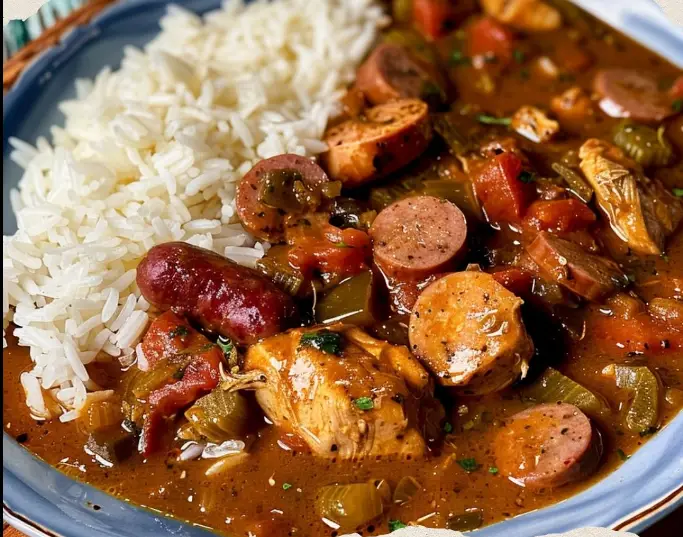Cajun cuisine is a vibrant and integral part of Louisiana’s cultural heritage, rooted in the traditions of the Acadian people who settled in the region. One of the most iconic dishes of this culinary style is gumbo, a hearty stew that embodies the flavors and history of Cajun cooking. This article will explore the rich history and significance of Cajun Chicken and Sausage Gumbo, a dish that has become synonymous with Southern comfort food.
Gumbo is more than just a meal; it’s a cultural symbol that represents the melding of various culinary traditions, including French, African, Spanish, and Native American influences. Each bowl of gumbo tells a story, with its dark, rich roux and flavorful ingredients reflecting the diverse heritage of Louisiana. Whether served at family gatherings, community events, or as a comforting meal on a chilly day, gumbo holds a special place in the hearts of many.
For those looking to dive deeper into Cajun cuisine, Wikipedia offers a comprehensive overview of its history and key elements. Additionally, Pinterest is a great resource for visual inspiration and variations on traditional gumbo recipes, such as this Cajun Chicken and Sausage Gumbo.
Ingredients Overview :
Creating an authentic Cajun Chicken and Sausage Gumbo requires a careful selection of ingredients, each playing a crucial role in the dish’s overall flavor and texture. Below, we’ll break down the key components:
- Chicken: Typically, boneless, skinless chicken thighs are preferred for their tenderness and flavor.
- Andouille Sausage: This smoked sausage adds a spicy, smoky depth to the gumbo.
- The Holy Trinity: A mixture of bell pepper, celery, and onion, this trio forms the base of many Cajun dishes, providing a rich, aromatic foundation.
- Okra: This vegetable not only adds flavor but also helps thicken the gumbo.
- Spices and Seasonings: Essential for achieving the distinct Cajun flavor. These include Cajun seasoning, gumbo file powder, and hot sauce.
For a more detailed exploration of these ingredients, check out this Wikipedia article on gumbo, which delves into the various components and their cultural significance.
When sourcing ingredients, quality matters. Fresh vegetables, high-quality chicken, and authentic andouille sausage are critical. Local markets or specialized stores often carry the best options, ensuring your gumbo is as flavorful as possible. For those interested in a deeper dive into Cajun ingredients, Pinterest offers a plethora of visual guides and tips.
By understanding the role each ingredient plays, you can appreciate the complexity and depth of Cajun Chicken and Sausage Gumbo. This knowledge also allows for creative variations, such as incorporating seafood or experimenting with different spice levels, tailored to your taste preferences.
Preparing the Ingredients :
Proper preparation is key to a successful gumbo. Here’s how to get started:
- Season the Chicken and Sausage: Generously coat the chicken and sausage with Cajun seasoning. This step infuses the meat with flavor, setting the stage for a rich, tasty gumbo.
- Chop the Holy Trinity: Dice the bell pepper, celery, and onion into small, uniform pieces. This ensures even cooking and helps meld the flavors together.
- Prepare the Okra: If using fresh okra, slice it thinly. For a less slimy texture, you can soak the slices in vinegar before adding them to the gumbo.
These steps might seem simple, but they are crucial for achieving the authentic flavor and texture of Cajun Chicken and Sausage Gumbo. For more detailed guidance on preparing these ingredients, you can refer to Cajun Holy Trinity on Wikipedia.
By taking the time to properly season and prepare your ingredients, you lay the foundation for a delicious gumbo. This attention to detail makes a significant difference in the final dish, ensuring each bite is packed with robust flavors.
Making the Roux :
The roux is the heart of any good gumbo, providing depth and richness to the stew. Here’s a step-by-step guide to creating the perfect dark brown roux:
- Heat the Oil: In a large pot, heat 1 cup of vegetable oil over medium heat.
- Add the Flour: Gradually whisk in 1 cup of all-purpose flour, ensuring no lumps form.
- Stir Constantly: This is the most critical part. Stir the mixture continuously to prevent burning. The process can take anywhere from 30 to 45 minutes.
The key to a great roux is patience. You’re aiming for a color that’s a deep, rich brown—similar to chocolate. This transformation is essential for the signature flavor of gumbo. For a more in-depth tutorial, this guide on Wikipedia provides an excellent overview of the process.
Once your roux reaches the desired color, it’s time to move to the next steps:
- Add the Holy Trinity: Stir in the chopped bell pepper, celery, and onion. Cook until the vegetables are soft, about 5-7 minutes.
- Incorporate the Garlic: Add minced garlic and cook for another 1-2 minutes until fragrant.
- Gradually Add Broth: Slowly pour in 6 cups of chicken broth, stirring constantly to ensure a smooth consistency.
The roux, combined with the Holy Trinity, creates a robust base for the gumbo. This mixture should be smooth and free of lumps. It’s at this stage that the flavors start to meld together, forming the backbone of your gumbo. For those interested in variations and tips, Pinterest offers a plethora of visual aids and additional techniques.
Creating a perfect roux requires practice and attention, but the effort is well worth it. A well-made roux will elevate your gumbo, providing a depth of flavor that is truly unparalleled.
Cooking the Gumbo :
Once your roux is prepared and your vegetables are soft, it’s time to start building your gumbo. Here’s how:
- Searing the Meats: In the same pot, heat a tablespoon of vegetable oil over medium-high heat. Add the seasoned chicken thighs and andouille sausage slices, searing until browned on all sides. This step helps to lock in the flavors and adds a caramelized depth to the gumbo.
- Combining the Ingredients: Return the seared chicken and sausage to the pot with the roux and vegetables. Stir to combine, ensuring that the meats are well-coated with the roux.
- Adding Broth and Simmering: Gradually pour in the chicken broth, stirring continuously to maintain a smooth texture. Bring the mixture to a simmer, reducing the heat to low. This slow cooking process allows the flavors to meld together beautifully.
For a deeper dive into the techniques of searing and combining ingredients, you can refer to this authentic gumbo recipe on Lauren From Scratch. Additionally, the Kitchn offers a comprehensive guide on the traditional methods used in Cajun gumbo preparation.
- Adding Spices and Seasonings: Now it’s time to enhance the flavor with spices. Add 2 teaspoons of Cajun seasoning, 1 teaspoon of hot sauce, 1 teaspoon of black pepper, and 1 teaspoon of gumbo file powder. Adjust the seasoning to taste, ensuring a well-balanced and flavorful gumbo.
- Incorporating Vegetables and Additional Ingredients: Add the sliced okra to the pot. Okra not only adds flavor but also acts as a natural thickener for the gumbo. If you prefer a thicker consistency, you can also add more gumbo file powder.
- Simmering and Stirring: Allow the gumbo to simmer on low heat for at least one hour, stirring occasionally. This slow cooking method is crucial for achieving the rich, layered flavors that are characteristic of an authentic Cajun Chicken and Sausage Gumbo.
- Adjusting the Seasonings: Taste the gumbo periodically, adjusting the salt, pepper, and other seasonings as needed. This ensures that the flavors are balanced and robust.
- Final Touches: Just before serving, add a final touch of chopped green onions and fresh parsley for a burst of color and freshness.
For more detailed cooking techniques and tips, you can explore the traditional methods outlined by Real Cajun Recipes and the in-depth guide on making a perfect gumbo from The Kitchn.
By following these steps meticulously, you’ll achieve a gumbo that’s not only delicious but also a true representation of Cajun cuisine. The slow simmering process allows the flavors to meld together, resulting in a dish that’s rich, hearty, and full of character.
Serving the Gumbo :
Serving Cajun Chicken and Sausage Gumbo is an art in itself. Here’s how to do it right:
- Preparing the Rice: Gumbo is traditionally served over a bed of white rice. Cook the rice according to package instructions, ensuring it’s fluffy and tender. A well-cooked rice will absorb the flavors of the gumbo, enhancing the overall dish.
- Plating the Gumbo: In a deep bowl, place a generous scoop of cooked rice. Ladle the hot gumbo over the rice, ensuring each serving gets a good mix of chicken, sausage, vegetables, and broth. This presentation not only looks appealing but also ensures each bite is full of flavor.
- Garnishing: Garnish the gumbo with finely chopped green onions and fresh parsley. These herbs add a fresh, vibrant note to the dish, balancing the rich, hearty flavors of the gumbo.
- Accompaniments: Gumbo can be served with various side dishes such as cornbread, French bread, or a simple green salad. These sides complement the gumbo and round out the meal.
For more serving tips and presentation ideas, check out this Pinterest board dedicated to gumbo recipes and plating techniques. Additionally, exploring traditional serving methods on Wikipedia can provide further insights.
By paying attention to these details, you ensure that your Cajun Chicken and Sausage Gumbo not only tastes amazing but also looks inviting and delicious. Serving the gumbo with the right accompaniments and garnishes elevates the dining experience, making it truly special.
Variations of Gumbo :
Gumbo is a versatile dish with numerous variations that cater to different tastes and dietary preferences. Here are some popular variations:
- Seafood Gumbo:
- Ingredients: Instead of chicken and sausage, this version uses a mix of seafood such as shrimp, crab, and oysters.
- Preparation: The base remains the same, with a dark roux and the Holy Trinity of vegetables. Seafood is added towards the end of cooking to prevent it from becoming overcooked.
- Flavor Profile: This variation is lighter and has a briny, oceanic flavor that pairs well with the spices.
- Reference: For a detailed recipe, check out this Seafood Gumbo from Tastes Better From Scratch.
- Vegetarian Gumbo:
- Ingredients: This version omits meat and seafood, focusing instead on vegetables like okra, tomatoes, and beans.
- Preparation: A vegetarian roux is made with vegetable oil and flour, and a variety of spices are used to mimic the depth of traditional gumbo.
- Flavor Profile: Despite lacking meat, vegetarian gumbo is hearty and flavorful, thanks to the variety of vegetables and robust seasoning.
- Reference: For inspiration, see this Vegetarian Gumbo Recipe on The Kitchn.
- Regional Variations:
- New Orleans Creole Gumbo: Typically includes tomatoes and a mix of meats such as chicken, sausage, and seafood. It’s often served with filé powder for extra thickness and flavor.
- Cajun Gumbo: Focuses on a dark roux and usually does not include tomatoes. It often features andouille sausage and is spicier compared to Creole gumbo.
- Reference: Learn more about these regional differences on Wikipedia.
By exploring these variations, you can appreciate the adaptability of gumbo and how it reflects the diverse culinary heritage of Louisiana. Whether you prefer a rich seafood version or a comforting vegetarian take, there’s a gumbo for every palate.
Cultural Significance :
Gumbo is more than just a dish; it’s a cultural icon that represents the heart and soul of Louisiana. Its origins are a testament to the blend of cultures that have influenced the region, including French, African, Spanish, and Native American traditions.
- Family and Community:
- Gatherings: Gumbo is often served at family gatherings, community events, and celebrations. It’s a dish that brings people together, embodying the spirit of hospitality and warmth.
- Traditions: Many families have their own gumbo recipes passed down through generations. These recipes often include personal touches and secret ingredients that make each pot of gumbo unique.
- Festivals and Celebrations:
- Gumbo Festivals: There are several gumbo festivals in Louisiana, such as the World Championship Gumbo Cookoff in New Iberia. These events celebrate the dish and its cultural importance, featuring cooking competitions, music, and community activities.
- Mardi Gras: During Mardi Gras, gumbo is a staple, providing sustenance for the festivities and reflecting the rich culinary heritage of the region.
- Personal Stories:
- Anecdotes: Many people who grew up in Louisiana have fond memories of making gumbo with their families. These stories often highlight the communal nature of cooking and the joy of sharing a meal with loved ones.
- Reference: For personal stories and deeper insights into the cultural significance of gumbo, Real Cajun Recipes offers a wealth of information and anecdotes.
Understanding the cultural significance of gumbo enhances its appreciation and highlights why it’s such a beloved dish. It’s not just about the flavors; it’s about the memories, traditions, and community it represents.
FAQs Section :
- What is the Holy Trinity in Cajun cooking?
- The Holy Trinity refers to the trio of vegetables—bell pepper, celery, and onion—used as the base in many Cajun dishes, including gumbo. It’s similar to the mirepoix used in French cuisine.
- Can I make gumbo without okra?
- Yes, you can make gumbo without okra. If you prefer a different thickening agent, you can use gumbo file powder or simply let the roux thicken the stew. Each method offers a slightly different texture and flavor.
- How do I store and reheat gumbo?
- Gumbo can be stored in an airtight container in the refrigerator for up to 3-4 days. For longer storage, freeze it in portion-sized containers for up to 2-3 months. Reheat gently on the stove, adding a little water or broth if it’s too thick.
- What is the difference between Cajun and Creole gumbo?
- Cajun gumbo typically features a dark roux and is spicier, often excluding tomatoes. Creole gumbo, on the other hand, may include tomatoes and has a more varied ingredient list, reflecting its diverse cultural influences.
For more detailed answers and additional questions, you can explore resources like Wikipedia or cooking sites such as The Kitchn.
Conclusion :
In conclusion, Cajun Chicken and Sausage Gumbo is not just a meal; it’s a culinary journey through the rich history and diverse cultural influences of Louisiana. From its origins to its variations and cultural significance, gumbo embodies the heart and soul of Cajun cuisine.
Whether you’re making a traditional gumbo with a dark roux and spicy andouille sausage or experimenting with a seafood or vegetarian version, the key is to use quality ingredients and take the time to let the flavors meld together. The result is a hearty, flavorful stew that’s perfect for any occasion.
For those interested in exploring more about Cajun cuisine and gumbo, Wikipedia and Pinterest offer excellent resources for recipes, cooking tips, and cultural insights.
So, gather your ingredients, take your time with the roux, and enjoy the process of making a dish that’s steeped in tradition and flavor. Gumbo is more than just food; it’s a celebration of community, culture, and the joy of sharing a delicious meal with loved ones.
Print
Cajun Chicken and Sausage Gumbo
- Author: Easy Recipes
- Total Time: 1 hour 30 minutes
Ingredients
1 pound chicken
12 ounces andouille sausage
1 tablespoon vegetable oil
1 cup all-purpose flour
1 ¼ cups vegetable oil (for roux)
6 cups chicken broth
1 cup bell pepper, chopped
1 cup celery, chopped
1 cup onion, chopped
1 cup okra, sliced
2 cloves garlic, minced
1 teaspoon black pepper
2 teaspoons Cajun seasoning
1 teaspoon hot sauce
1 teaspoon gumbo file powder
Salt to taste
Cooked white rice for serving
Instructions
Season the chicken and sausage with Cajun seasoning.
Heat vegetable oil in a large pot over medium heat. Sear the chicken and sausage until browned. Remove and set aside.
In the same pot, make a roux by combining the vegetable oil and flour. Stir constantly over medium heat until the roux turns a dark brown color.
Add the bell pepper, celery, onion, and garlic to the roux. Cook until vegetables are soft.
Gradually stir in the chicken broth, bringing the mixture to a simmer.
Add the okra, black pepper, hot sauce, and gumbo file powder. Stir to combine.
Return the chicken and sausage to the pot. Simmer for 1 hour, stirring occasionally.
Season with salt to taste and serve hot over white rice.
- Prep Time: 15 minutes
- Cook Time: 1 hour 15 minutes
Nutrition
- Serving Size: 6 servings
- Calories: 400 kcal




